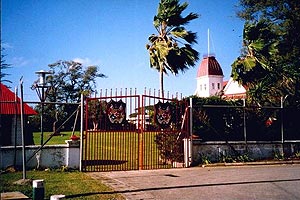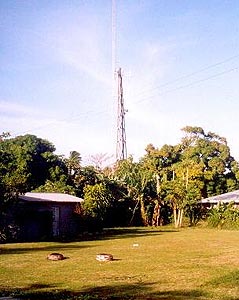|
Friday the 13th
became my lucky day
Nailing Tonga
by Mika
Mäkeläinen
This would be the time,
I thought. If it ever was possible to catch a station
from the South Pacific, today Friday, November 13th
1998, the conditions seemed ideal. The steady flow
of Alaskan and Hawaii stations indicated that the
path over the North Pole was open. Russian Far East
stations on shortwave were unusually strong. I began
browsing through selected frequencies until a weak
signal on 1017 kHz caught my attention.
Mediumwave stations from the
Pacific have always been among the most valued targets
for Finnish DXers. My first 18 years of DXing had
netted me 16 verified stations from Hawaii and 3
from Australia - until the dawn of November 13th
1998.
The last full day of the DXpedition
LEM121
began with below average conditions to North America
during the night. Sunrise in Lapland was typically
the best time to receive stations from the Western
hemisphere, and on this lucky Friday I was able
to identify a couple of U.S. stations including
KTOP on 1490 kHz. I also logged some nice Europeans,
such as Sud Radio on 819 kHz and RNE Monforte de
Lemos with regional programming for Galicia on 972
kHz.
But as conditions soon deteriorated,
I resorted to shortwave DXing, and ended up recording
the closing of the regional Tikhy Okean program
from Khabarovsk on 7210 kHz. Incidentally, the name
of the program means Pacific Ocean. At 0900
UTC Tikhy Okean was replaced by the national Vesti
newscast and it was time to move on.
Keyword North
The AM band was mostly quiet,
hardly anything from the Western hemisphere. Still,
roughly 15 Alaskan stations were audible, as well
as several Hawaii stations. This was unusually many
stations from there, but still I found nothing new
for me. I also noticed that not only Khabarovsk,
but other Russian Far East shortwave stations were
coming louder than on any previous day. All of this
had one common feature; the direction of the signals,
as they were coming over the North Pole, a difficult
route, which is very often silenced by magnetic
disturbance. The day was exceptional also in that
sense; in just one day, the A-index shot up from
just 1 to a staggering 44.
All of this led me to try the
impossible - hunt other, more distant AM stations
from the Pacific. I wandered through the AM band,
which on 9-kiloherz intervals only seemed to offer
some weak European stations. I checked the WRTH
for potential South Pacific frequencies until on
1017 kHz I heard music which immediately gave me
the shivers in a positive sense. These kind of songs
I had previously heard on the provincial shortwave
stations of Papua New Guinea!
I quick check with the WRTH revealed
no PNG here, but Tonga instead. It was 0935 UTC.
I alerted my fellow listener Jim
Solatie. Both of us were still more or less
in disbelief, but Jim began to look for other stations
in the area, while I began recording the weak signal,
which occasionally became totally inaudible but
regained power even after a long absence.
I thought of other possibilities,
including Taiwan, which had fooled me to follow
its programming for quite some time during an earlier
DXpedition, but none of the other stations listed
on the frequency fitted to what I heard. The language
of the female announcer on the air reminded me of
Pidgin. As I later learned, the language was Tongan,
not really related but with some common features.
I recognized a few English words, but other than
that the talk was total gibberish to me.
At 0945 the music program gave
way to a talk program, which I initially thought
would have been some type of news or current affairs
program. As I learned much later from a telephone
conversation with the Tonga Broadcasting Commission,
it was actually personal messages connecting people
living on different islands, very much like the
well-known comunicados of the Andean stations in
South America. I was later told that the messages
were read by former chief announcer Ms. Mele Heimuli,
who retired in 1999. This continued over the top
of the hour without any recognizable station identification.
Music programming resumed, again of the type I had
learned to expect from Pacific stations. The signal
was more or less audible until around 1030 UTC,
after which it no longer surfaced.
Nothing else from
the region
Most of the time I used two receivers
and two tape recorders, just in case. The signal
was best audible with my 800-meter-long Far-East
antenna pointed at about 45 degrees. The antenna
straight north to Alaska gave an even weaker signal,
other antennae were totally useless. I was still
in doubt; much seemed to support my theory of Tonga,
but with no station identification, I didn't have
much concrete evidence to brag about. However, I
had enough recordings for a tentative reception
report, which I sent as soon as I returned back
home from Lapland.
Meanwhile, Jim had no luck. Some
stations in the area had obviously already signed
off, and others were just not audible. But somewhat
later in the day, after 1245 UTC, I caught KTWG
from Guam on 801 kHz, quite a rare catch, and another
indication of the very unusual reception conditions
favoring the Pacific that day. Also some Japanese
and Philippino stations were identified, but nothing
really sensational.
Report lost in
the Ocean
My first reception report sent
in express mail probably got lost on the way to
Tonga. Unlike the other major catch of the day,
KTWG, which sent a QSL-card along with a kind letter
confirming my reception of their program titled
Turning Point. The turning point of my QSL-hunt
was however still to come. I became anxious, not
knowing if I really had nailed Tonga or not.
I sent a tape to a fellow DXer
Paul Ormandy in New Zealand who tried to get some
sense of the tape by contacting Tongan-speaking
people. No luck.
In March 1999 I sent a follow-up
report and later an inquiry by telefax. This finally
prompted Chief Engineer Sioeli Maka Tohi to send
his kind confirmation letter by telefax. Later by
mail I also received their traditional QSL card
featuring call-letters A3Z.
Sioeli Maka Tohi was able to
confirm the report as all the details matched their
program rundown. Later he also told me that they
had recognized the announcers on the tape. Finally!
The station had never before been heard in Europe
on AM. For me Tonga became the 200th verified country
according to the conservative count of the Finnish
DX Association. A fitting reward indeed.
The nation and
the station

The Royal Palace in Nuku'alofa
(photo by Bob Padula, July 2004) |
Tonga is a parliamentary kingdom
of 110 000 inhabitants scattered over dozens of
islands totalling 750 square kilometers. The capital
Nuku'alofa is located on the main island of Tongatapu.
Like most smaller Pacific nations, Tonga is relatively
poor - for example Finland's per capita GDP is eight
times higher.
A3Z Radio 1 on 1017 kHz, with a power of 10 kilowatts,
is the only AM transmitter in the country. Both
the public broadcaster Tonga Broadcasting Commission
(TBC) - known as the Call of the Friendly Islands
- and its private competitors have transmitters
on FM. Until now only private companies have ventured
into television, but TBC is planning to set up a
TV station. Originally the deadline was November
1999, but it has been postponed, says Chief Engineer
Maka Tohi.
Until 1992 TBC used to operate
also a 1-kilowatt shortwave transmitter, which was
never heard in Finland. The transmitter has broken
down, and there are no plans to fix in the near
future, because AM easily covers the entire nation.
TBC contact information listed
in the World Radio TV Handbook is valid. In 2000
the station briefly had its own website, complete
with samples of their station identifications and
a chance to shop for TBC souvenirs, but unfortunately
it has been gone since early 2001.

The antenna tower of TBC
in Nuku'alofa (photo by Bob Padula, July 2004) |
Tonga Broadcasting Commission
has a staff of 60 people to run two radio channels,
both nearly 18 hours a day. Broadcasts are in Tongan
and English, with relays from the BBC, Radio Australia
and Radio New Zealand. Interestingly, the station
is not financed by license fees or through the state
budget, but by advertising revenue and profits from
a retail radio shop, which is owned by the TBC!
A3Z was established in 1960 to
provide a link connecting the people of the different
remote islands. Even after the arrival of telephone,
linking the people is still a primary function.
Broadcast time is given to various churches, community
and civic organizations, as A3Z is the only station
that covers the entire nation - and, as it seems,
occasionally reaches much beyond!
Reception best
in broad daylight
The distance from Lapland to
Tonga is approximately 14500 kilometers, much more
than to Hawaii (about 9800 km), but still less than
to New Zealand. For example, an AM station from
Wellington more than 16000 km away has been logged
in Finland. Tonga however is located much further
north if you think of the true direction from Lapland,
and therefore may require different reception conditions.
A closer look at the time of
reception may be helpful when planning other conquests
in the Pacific. Theoretically it seems that Tonga
and the surrounding countries could be audible even
much earlier than 0930 UTC. In fact, sunset in Tonga
in mid-November is already at 18.57 Tongan time,
equal to 0557 UTC. Theoretically, again, this sounds
very good as the entire path from Finland to Tonga
is in darkness, as compared to 0930 UTC, when Lapland
is already in daylight and the signal has to pass
in sunlight for hundreds of kilometers.
However, what makes 0930 UTC
a much better time than the earlier hours is that
around 0600 UTC signals from West Europe are still
very strong and even with a directional antenna,
it would be difficult to avoid European interference.
On the contrary, at 0930-1030 UTC the sun shines
over entire Europe and interfering signals are weaker
than at any other time of the day - thus allowing
the truly far-away and weak stations to be heard.
Keep this in mind next winter - who knows what other
island nations can be heard across the globe!
And a wish for the future: It would be fantastic
to actually visit Tonga, some day.
(published on September
13th 1999, last update on March 19th 2001, photos
added on October 7, 2004)
  
|